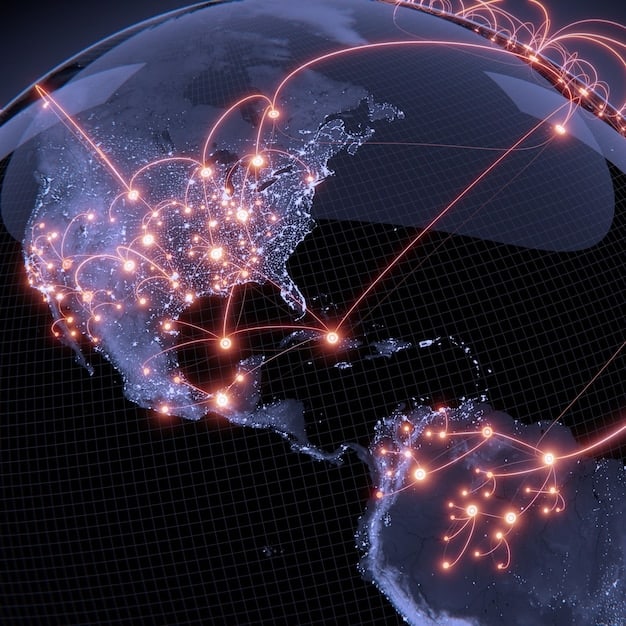Blockchain in US Supply Chains: A Revolution in the Next 5 Years?

Blockchain technology has the potential to revolutionize US supply chains within the next five years by enhancing transparency, security, and efficiency across various industries.
Will blockchain technology truly revolutionize US supply chains in the next five years? The potential is undeniable, but the path to widespread adoption is complex. Let’s delve into the possibilities and challenges facing this transformative technology.
Understanding Blockchain’s Potential in Supply Chains
Blockchain technology offers a secure and transparent way to track goods and information throughout the supply chain. Its decentralized nature can reduce inefficiencies and improve trust among participants. But what exactly does this mean for US supply chains?
Enhanced Transparency and Traceability
One of the most significant benefits of blockchain is its ability to provide end-to-end visibility. Every transaction is recorded on a distributed ledger, making it easy to track the movement of goods from origin to the final consumer.
Improved Security and Reduced Fraud
Blockchain’s cryptographic security measures make it extremely difficult to tamper with data. This reduces the risk of fraud, counterfeiting, and theft within the supply chain.
- Immutable Records: Data cannot be altered once it’s recorded on the blockchain.
- Decentralized Network: No single point of failure, making the system more resilient.
- Smart Contracts: Automate processes and ensure compliance with predetermined rules.
Blockchain has the power to transform the fragmented nature of supply chains, making it possible to trace products throughout and ensure that they meet certain criteria, from ethical and environmental standards to proper handling and delivery.

Current Applications and Pilot Programs
While the revolutionary impact of Blockchain is still on its way, several companies are already exploring ways to leverage blockchain in their supply chain operations. From tracking food origins to tracing pharmaceuticals, the use cases are diverse.
Food and Agriculture
Companies like Walmart and IBM are using blockchain to track food products from farm to store. This allows them to quickly identify and remove contaminated products from shelves, reducing the risk of foodborne illnesses such as E. coli.
Pharmaceuticals
The pharmaceutical industry is using blockchain to combat counterfeit drugs and ensure the integrity of the supply chain. This is especially important for high-value medications where counterfeiting is a major concern.
Luxury Goods
Luxury brands are adopting blockchain to verify the authenticity of their products and prevent counterfeiting. This not only protects their brand reputation but also ensures that customers are getting genuine products.
Pilot programs across various industries demonstrate the potential for transforming the way goods are moved and verified, pointing toward a future in which supply chains are not just efficient, but also exceptionally secure and transparent.
Challenges to Widespread Adoption
Despite its benefits, there are several hurdles to overcome before blockchain can be widely adopted in US supply chains. These include regulatory uncertainty, a lack of standardization, and the complexity of integrating blockchain with existing systems.
Regulatory and Legal Uncertainty
The regulatory landscape surrounding blockchain is still evolving. This uncertainty can make it difficult for companies to invest in blockchain solutions, as they may not be sure how these technologies will be treated under the law.
Lack of Standardization and Interoperability
There are many different blockchain platforms and standards, and they are not always compatible with each other. This lack of interoperability can make it difficult for companies to share data across different supply chain networks.
Complexity and Integration Costs
Integrating blockchain with existing supply chain systems can be complex and expensive. This is especially true for companies that have legacy systems that are not designed to work with blockchain.

Overcoming Barriers and Scaling Blockchain Solutions
Overcoming these challenges will require collaboration among industry stakeholders, including governments, businesses, and technology providers. Standardized protocols, clearer regulations, and user-friendly applications will be critical.
Collaboration and Standardization
Industry-led initiatives, such as the Blockchain in Transport Alliance (BiTA), are working to develop common standards and protocols for blockchain in supply chain. These efforts are essential to ensure interoperability and promote widespread adoption.
Government Support and Regulation
Governments can play a role by providing regulatory clarity and supporting research and development of blockchain technologies. This can help to reduce uncertainty and encourage investment in blockchain solutions.
User-Friendly Applications and Education
To encourage adoption, blockchain solutions need to be easy to use and understand. This requires developing user-friendly applications and providing education and training to supply chain professionals.
The Role of Will Blockchain Revolutionize US Supply Chains in the Next 5 Years?
Forecasting the role of will blockchain revolutionize us supply chains in the next 5 years involves considering ongoing developments, potential breakthroughs, and real-world adoption rates.
Incremental Improvements and Strategic Investments
Companies that make strategic early investments in blockchain for supply chain management may find themselves well-positioned to lead their respective industries when standards become more uniform.
Smart Contracts and Automation
The automation capacities of smart contracts may allow improvements and efficiencies in areas such as inventory management, payments facilitation, and adherence to contractual obligations throughout the supply network.
Improved Data Analytics and Decision Making
As blockchain tech improves the quantity and quality and security of data accessible to supply chain stakeholders, chances exist for more informed business choices, risk management and resource allocation.
Future Trends and Innovations
Looking ahead, several key trends are likely to shape the future of blockchain in US supply chains. These include the integration of blockchain with other emerging technologies, the development of more sophisticated smart contracts, and the rise of decentralized supply chain platforms.
Integration with IoT and AI
Integrating blockchain with the Internet of Things (IoT) and artificial intelligence (AI) can further enhance supply chain efficiency and transparency. IoT sensors can provide real-time data on the location and condition of goods, while AI can be used to analyze this data and make predictions about future supply chain events.
Advanced Smart Contracts
As blockchain technology matures, we can expect to see the development of more sophisticated smart contracts. These contracts can automate complex supply chain processes and ensure compliance with a wide range of regulations and standards.
Decentralized Supply Chain Platforms
Decentralized supply chain platforms can enable companies to collaborate directly with each other, without the need for intermediaries. This can reduce costs, improve efficiency, and foster greater trust among participants.
| Key Point | Brief Description |
|---|---|
| 🔗 Transparency | Blockchain provides end-to-end visibility of goods movement. |
| 🛡️ Security | Improved security measures reduce the risk of fraud and theft. |
| 🤝 Collaboration | Standardization is essential for widespread adoption. |
| 🤖 Automation | Smart contracts automate processes such as payments and inventory. |
FAQ
▼
Blockchain is a decentralized, distributed ledger technology that records transactions across many computers. It ensures data integrity and transparency by making records immutable.
▼
Blockchain provides a transparent and traceable record of each transaction in the supply chain. Every party can view the history, enhancing accountability and reducing fraud.
▼
The main benefits include increased transparency, improved security, reduced fraud, faster transaction times, and lower administrative costs. These efficiencies benefit all stakeholders.
▼
Challenges include regulatory uncertainty, lack of standardization, high integration costs, scalability issues, and the need for collaboration among various supply chain participants.
▼
Several industries are exploring blockchain, including food and agriculture, pharmaceuticals, luxury goods, and shipping. These industries aim to improve traceability and reduce counterfeiting.
Conclusion
While the full-scale revolution of US supply chains by blockchain in the next five years may face hurdles, the technology’s potential is evident. As challenges are addressed through collaboration, standardization, and technological advancements, blockchain is poised to play a significant role in shaping the future of supply chain management.





